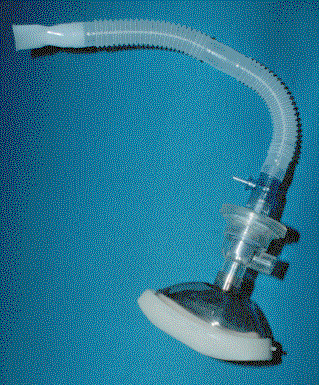
A Higher Concentration Oxygen Delivery Pocket Mask
by
Larry "Harris" Taylor, Ph.D.
This is an
electronic reprint of an article that appeared in NAUI NEWS (Mar/Apr 1989, p. 40
& Alert Diver, Fall, 1989. p. 15). This material is copyrighted and all
rights retained by the author. This article is made available as a service to
the diving community by the author. It may be distributed for any non-commercial
or Not-For-Profit use.
All rights reserved.
Go To: Home About "Harris" Articles Slides War Stories Editorials Links Fini
Nearly all divers are aware that breathing a high
concentration of oxygen is the preferred field treatment for a serious diving
malady. Most of the oxygen delivery devices on the market require a breathing
victim. The current standard of care for a first responder sport diver in
dealing with a non-breathing patient is oxygen supplemented mouth-to-pocket mask
resuscitation.
However, the typical pocket mask at 10 l/min only delivers
about 50 % O2 to the patient. Since the non-breathing patient is in
perhaps desperate need of higher O2 levels, sport diving first
responders need some method of increasing the oxygen concentration that can be
delivered in the field.
One possible remedy is to modify a disposable (single-patient
use) pocket mask resuscitator (InterTech # 008010, or equivalent). This unit (designed for use in C.P.R.)
comes with a pocket mask, a one-way fish-valve assembly (to isolate the
patient's breath from the rescuer), a short piece of respiratory tubing, and a
mouthpiece. By adding a T-adaptor oxygen inlet (Airlife U/Adapit # 004081, or
equivalent) and increasing the length of the respiratory tubing to greater than
12" (The tubing acts as an oxygen reservoir; the longer the tubing, the higher
the oxygen concentration that will be delivered.) This device can furnish 60-70 %
O2 to the patient at 10 l/min. (Of course, the actual concentration
delivered will be dependent on the precise liter-flow, quality of the mask seal,
length of the reservoir tubing, respiratory rate and volume of the
rescue-breathing, etc.)
Assembly of
the mask arrangement is shown in the photo below. Consult your local hospital
supply vendor for parts. Once assembled, practice your oxygen administration
technique under the watchful eye of a knowledgeable dive rescue or oxygen
administration instructor.
This simple modification is safe and convenient to use,
inexpensive and it will increase the amount of oxygen delivered to a
non-breathing patient.

More
on oxygen delivery devices can be seen at
Oxygen Delivery Devices
Go To: Home About "Harris" Articles Slides War Stories Editorials Links Fini
About The
Author:
Larry "Harris" Taylor, Ph.D. is a biochemist and Diving Safety
Coordinator at the University of Michigan. He has authored more than 200 scuba
related articles. His personal dive library (See Alert Diver, Mar/Apr, 1997, p.
54) is considered one of the best recreational sources of information In North
America.
All rights reserved.
Use of these articles for personal or organizational profit is specifically denied.
These articles may be used for not-for-profit diving education